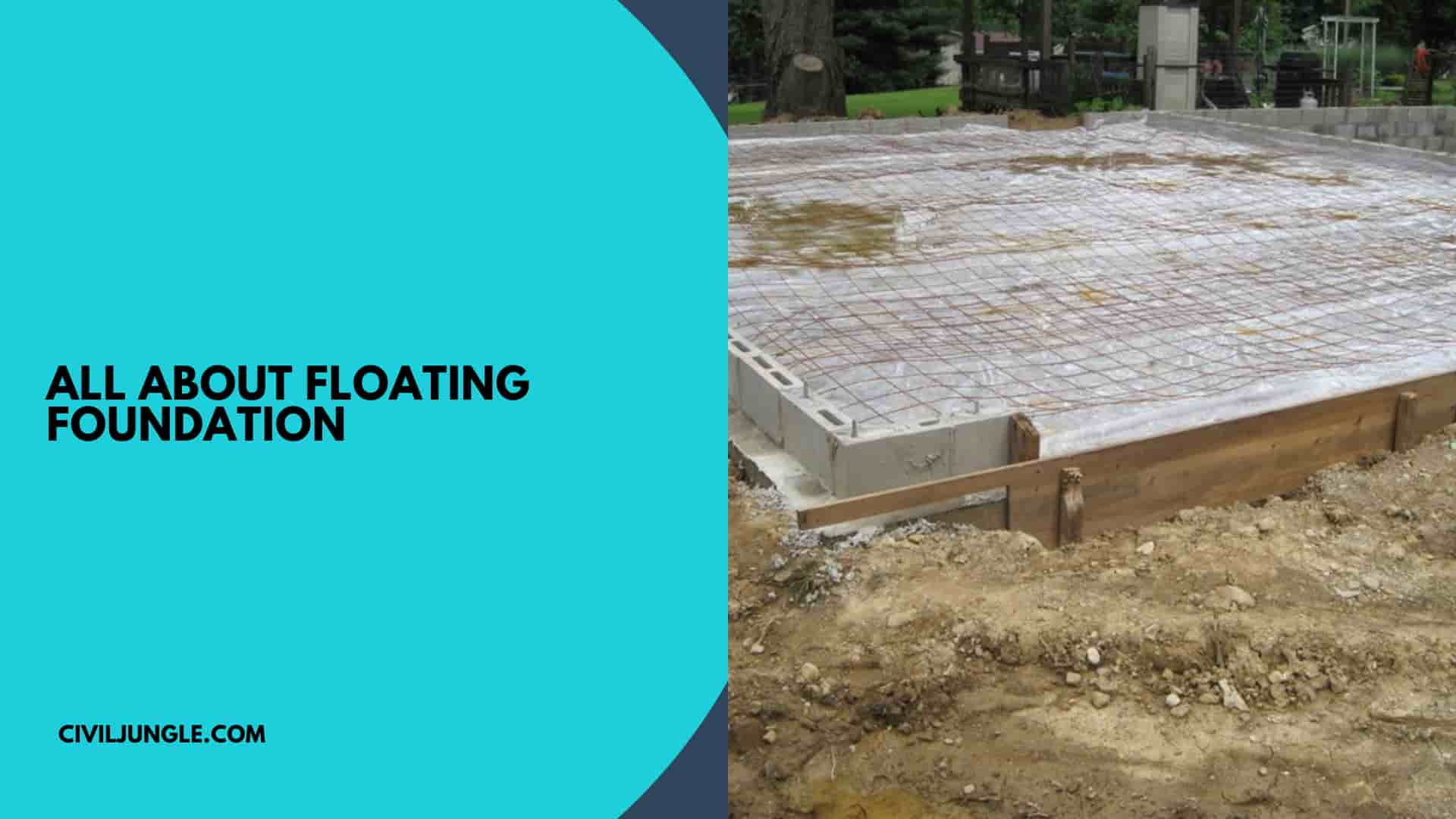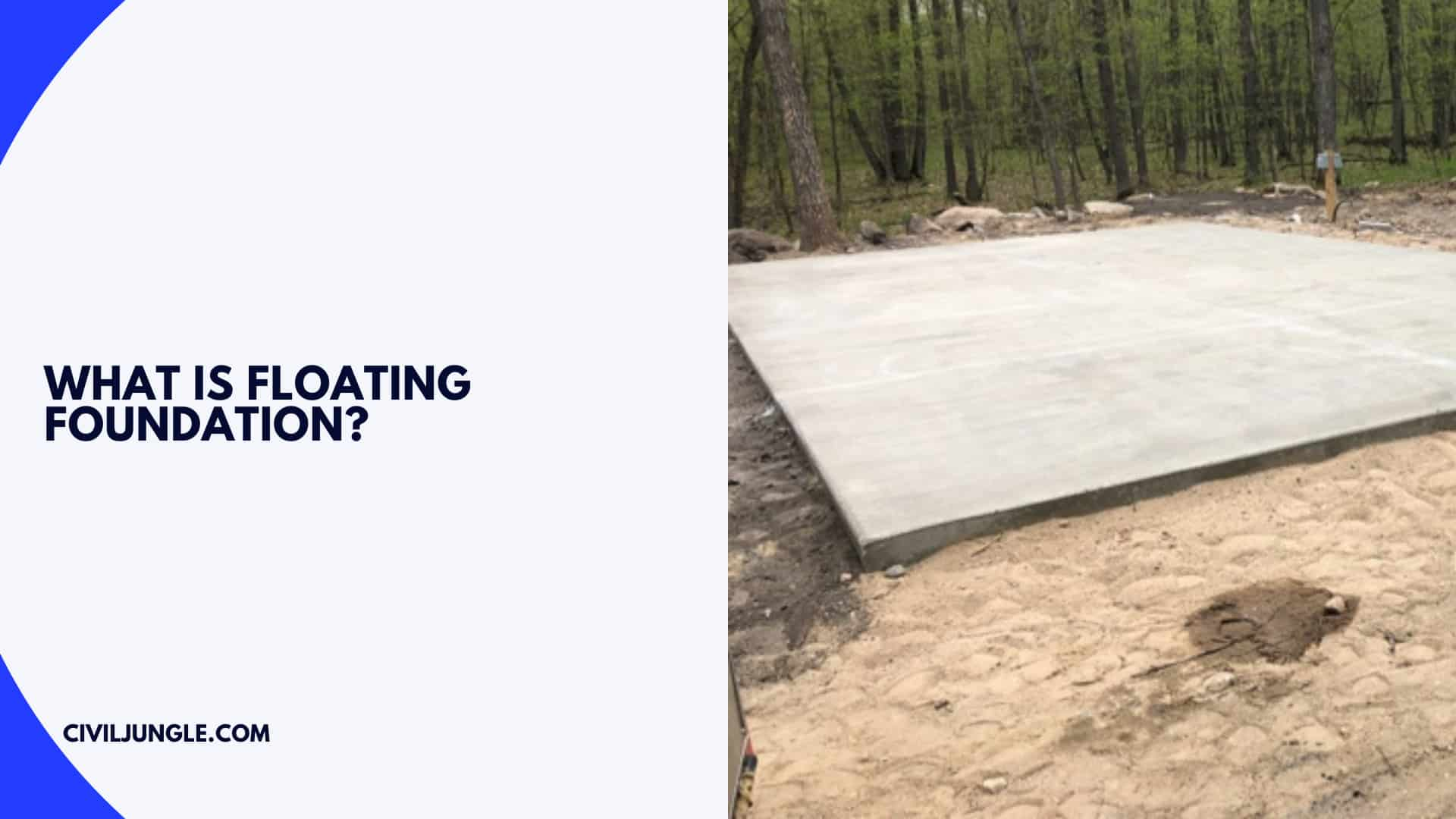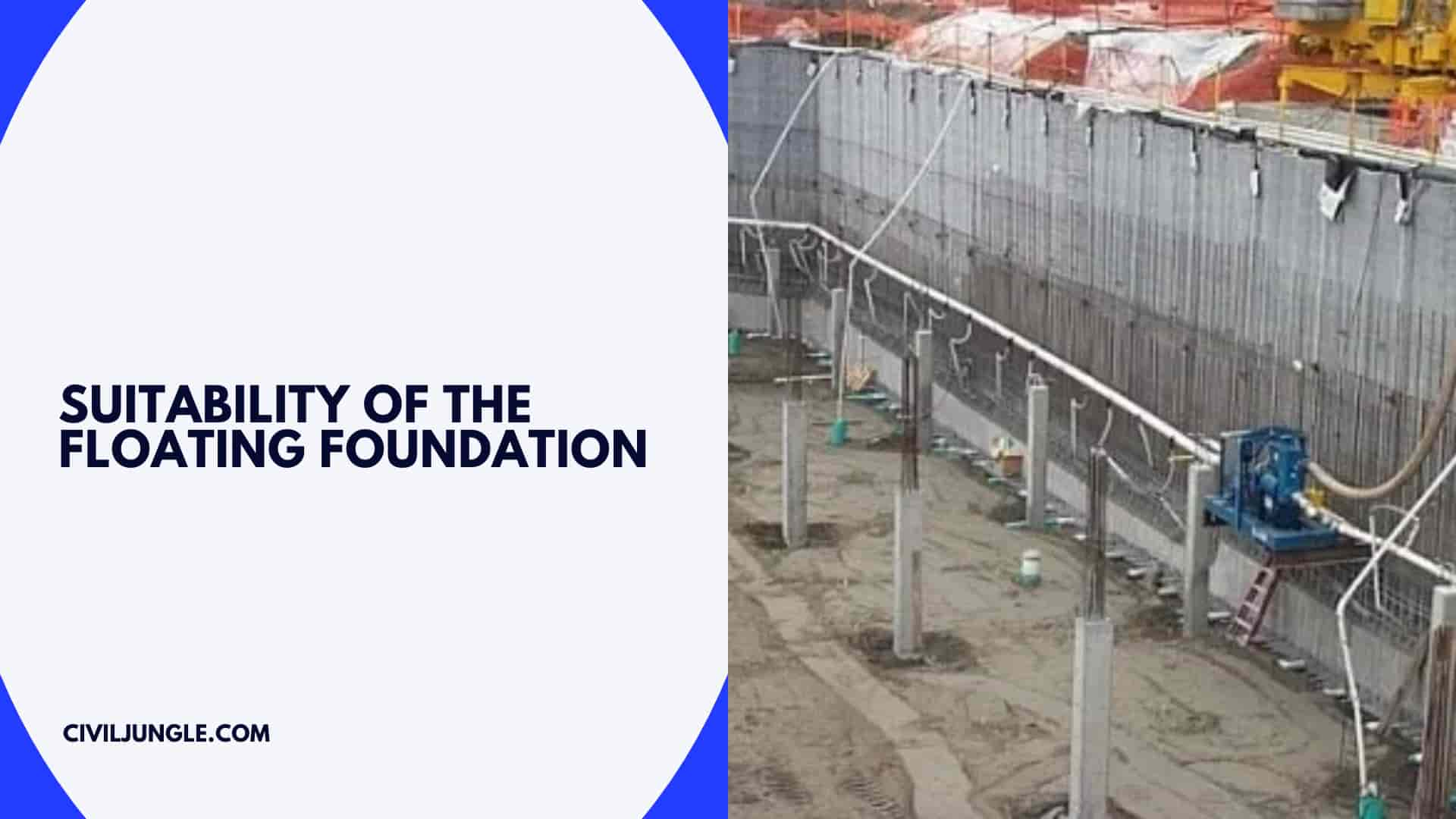Introduction of Floating Foundation
Important Point
Foundation is one of the most important parts of the structure which carries the total load of the Structure and transmits it to the underneath strata.
There are many parameters which have to be properly studied by the Geotechnical engineer before the construction of foundation otherwise there will be major problems of settlement can occur.
The total displacement which occurs on the Foundation level is known as the settlement of the foundation. The settlement of foundation is generally occurred and measured in the millimetres, but it can cause great damage to the structures.
Settlement of the Foundation is one of the major problems which are faced by the Engineers. There are many factors which cause the settlement of the foundation such as the low bearing capacity of the soil, poor compaction of soil etc.
If the settlement of the foundation is severe, then there may be chances of the collapse of the whole Structure. There are different techniques and methods are used to reduce the settlement of the foundation.
The construction of the Floating foundation is one of the best methods which is used to reduce the settlement of the foundation of the structure. In this article, you will get to know about the Floating Foundation, its Advantages and Disadvantages.
What is Floating Foundation?
Floating foundation is one of the best technique which is used for the construction foundation. The floating foundation provides a stable platform for the superstructure of the buildings and causes zero settlement in the foundation.
The Floating Foundation is a type of foundation which is constructed by the excavation of the soil in such a way that the weight of the structure which is built on that soil is equal to the total weight of the soil which is excavated including the weight of the water in the soil.
The term Floating is used in the Foundation Engineering when the soil under the footing or Foundation does not experience any extra load because the load of the building is equal to the soil which is displaced or excavated.
This Floating Foundation helps to reduce the total and differential settlement of the foundation by decreasing the net applied load by excavation. The function of the Mat Floating foundation is to spread the load over the larger area.
The Floating Foundation is also known as the balancing Raft Foundation. The main purpose of the construction of the Floating foundation is to balance the weight of the excavated soil by the construction of the structure of the same weight. It provides stability to the structure and zero settlement.
The construction of Floating foundation house is the similar concept in which the houses are constructed on the water in such a way that the load of the houses is equal then the uplift force of the water which helps in the floating the house on the water.
Floating concrete foundation consists of a rigid structure such that the depth below the ground that the weight of the soil removed to be equal to the weight of the building.
Suitability of the Floating Foundation
The suitability of the Floating foundation are as follows
- Floating foundation is suitable for the soils which have a problem of differential settlement under the heavy loads. The floating foundation helps to reduce the settlement of the foundation at a great extent.
- It is widely used in the soils which have low shear strength.
- It is also used in the soils which do not have any hard or stiff layer at a reasonable depth. In such a case, the floating foundation helps to reduce shear stress.
Also, Read: Brick Masonry Calculator | Brick Masonry Calculator | Size of Bricks | Calculate Brick Work
Useful Article for You
- What Is Composite Wood
- What Is the Difference Between a Shower Pan and a Shower Base?
- What Is a Window Panel
- What Is Rebar Made Of
- What Is Crane
- What Is a Frame Structure
- What Is the Measurement for a Queen Size Bed
- What Is Considered Livable Space
- What Is One Way You Can Save Electricity?
- What Is Mdf Mean
- House Footing Design
- What Is a Bundle of Shingles
- What Is a Gallon of Water Weigh
- What Is Window Sash
- What Is a Sieve Analysis
- What Is the Little Black Diamond on a Tape Measure
- What Is the Difference Between a Bolt and a Screw?
- What Is Overhang
- What Is a Contour Interva
- What Is a Spread Footing
- What Is a Pitched Roof
- What Is Tile
- What Is Leveling
- What Is Modulus of Rupture
- What Is a Caisson
- What Is a False Ceiling
- What Is the Lightest Weight Wood
- What Is Sandblasting
- What Is Flooring
- What Is the Strongest Foundation for a House
- What Is an Admixture
- Pile Foundation Cost Calculator
Challenges in the Construction of the Floating Foundation
There are many difficulties which engineers have to face during the construction process of the floating Foundation.
This problem can be prevented by taking proper care during the construction which is given as follows
- Excavation for the Foundation
- Dewatering
- Bottom Heave
1. Excavation for the Foundation
- The excavation for the foundation should be done with proper care air and the side of the excavation should be supported by the sheet piling.
2. Dewatering
- The process of the watering should be done with proper care such that it does not affects the adjoining structures.
- If the depth of the excavation which is required for the foundation is below the groundwater table then it is very necessary that the watering should be done.
3. Bottom Heave
- When the excavation is to be done at a specific depth, it reduces the pressure in the soil due to which the heaving of the bottom of the excavation occurs.
- Heaving can be minimised by the excavation in the narrow trenches and filling it with the concrete.
Also, Read: How to Calculate Cutting Length of Stirrups in Beam and Column
Advantages of Floating Foundation
The advantages of the floating Foundation are as follows
- Floating Foundation is used in the high moisture soils.
- Floating Foundation provides good stability to the structure.
- Floating Foundation helps to reduce the settlement of the structure.
- Floating Foundation can be used where the deep excavation is not required.
Disadvantages of the Floating Foundation
The disadvantage of the floating Foundation are as follows
- In the case of the Floating foundation, it is difficult to repair the electric or plumbing problems.
- The construction of the floating Foundation required Skilled workmanship.
- Due to improper construction, there may be chances of cracks in the houses which is difficult to repair.
Useful Article For You
- Types of Doors
- Parapet Wall
- Flight of Stairs
- Sheeps Foot Roller
- Moment Frame
- Edm Instrument
- Monolithic Slab
- Zero Force Members
- How Much Does a Yard of Concrete Weigh
- Live Load Vs Dead Load
- Cmu Wall Meaning
- Gradient Road
- Pile-Cap
- Bond Breaker
- Budget Sunroom Ideas
- What Is Gypsum Board
- Types of Vaulted Ceilings
- Concrete Cold Joint
- Well Points
- Abutment Bridge
- Finishing Plaster
- Spandrel Beam
- How Does Baking Soda Remove Blood from Carpet
- What Are Forms in Construction
- Dry Pack Mortar
- Wall Material
- Mat Foundation Vs Spread Footing
How to Build a Floating House Foundation?
- Floating Foundation house is constructed with the concrete float which ends up floating because it is displacing water.
- During the construction of the floating house Foundation, excavation should be done with proper measures.
- The float building materials are highly recyclable material and it can be reused. The float building materials do not cause any harm to the environment.
- The foundation of the floating houses should be constructed in such a way that it helps in floating as well as to take the dead of the house.
- Due to scarcity of the land the floating house will be in the great demand.
- Floating Foundation house is the need of the future which can be widely used in the coastal areas and the flood prone areas.
Floating Foundation
A floating foundation is a type of foundation constructed by excavating the soil in such a way that the weight of structure built on the soil is nearly equal to the total weight of the soil excavated from the ground including the weight water in the soil before the construction of a structure.
Floating Concrete Foundations
A floating foundation consists of boxlike rigid structures set at such a depth below ground that the weight of the soil removed to place it equals the weight of the building; thus, once the building is completed, the soil under it will bear the same weight.
Floating House Foundation
A floating foundation consists of boxlike rigid structures set at such a depth below ground that the weight of the soil removed to place it equals the weight of the building; thus, once the building is completed, the soil under it will bear the same weight… In construction: Foundations.
What Is Floating House Foundation?
Is a Floating Foundation Good?
Floating foundations are desirable for the following types of soils: Soils which are having good shear strength but having a problem of large settlements and differential settlements under heavy loads. Soils which are having low shear strength and there is no hard layer of soil at reasonable depth.
How Thick Should a Floating Foundation Be?
The average minimum thickness of the foundation must be at least 200mm. The strength of the concrete used for unreinforced strip footing must be at least 15MPa or better.
How Does a Floating House Work?
Think of a floating home like a condo, but rather than a unit in a building, it’s a unit on the water with HOA dues paid to maintain the dock and slip. Floating homes are permanently connected to sewer, water and electrical, built and moved into place just once.
Like this post? Share it with your friends!
Suggested Read –
- Gypsum Plasters
- Top 10 Tiles Companies in India 2020
- What Is Plaster | Requirement of Good Plaster | Types of Plasters
- What Is Beam Bridge | Types of Beam Bridges | Beam Bridge Works | Advantages & Disadvantages of Beam Bridges
- What Is Hydraulic Cement | Hydraulic Cement Uses | How to Apply Hydraulic Cement | Advantages & Disadvantages of Hydraulic Cement
- What Is Rock Cycle | Types of Rocks | Processes in the Rock Cycle | What Are the Steps of the Rock Cycle | Uses of Rocks in the Construction
- What is Waffle Slab| Waffle Slab Details | Advantages & Disadvantages Waffle Slab | Waffle Slab Design | Construction of Waffle Slab
Originally posted 2023-09-04 17:40:21.






Leave a Reply